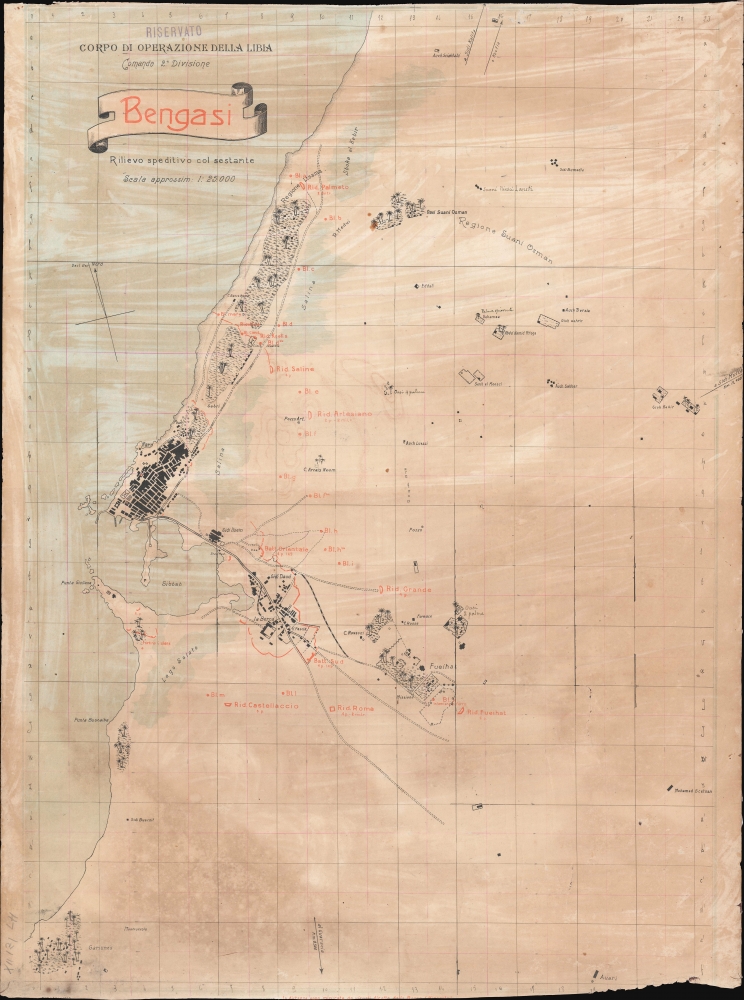This item has been sold, but you can get on the Waitlist to be notified if another example becomes available, or purchase a digital scan.
1912 Italian Army Chart or Map of Benghazi, Libya
Bengasi-italian-1912$900.00

Title
Bengasi.
1912 (dated) 26 x 19.5 in (66.04 x 49.53 cm) 1 : 25000
1912 (dated) 26 x 19.5 in (66.04 x 49.53 cm) 1 : 25000
Description
A rare find of considerable historical significance, this is a 1912 Italian military map of Benghazi (Bengasi), Libya, during the Italo-Turkish War (1911 - 1912). Benghazi was one of the first Libyan cities occupied by the Italian army, along with Tripoli, Tobruk, and Derna.
A Closer Look
The city itself appears on the left side of the map, with city streets and blocks recognizable. Roads and railroads are also depicted, along with smaller settlements scattered along the road leading to the southwest. Oases and what are likely private villas or estates are illustrated and labeled, often in manuscript.Fortifications
Red text highlights Italian fortifications surrounding Benghazi, including redoubts (labeled 'rid.') manned by machine guns ('mitr.'), two artillery batteries, and outposts scattered along a defensive line. Red lines mark what we believe to be the trenches with which the Italians fortified Benghazi.Benghazi During the Italo-Turkish War
Very few areas occupied by the Italians during the Italo-Turkish War experienced as much sustained fighting as Benghazi. The Italians arrived off the coast of Benghazi on October 18, 1911, demanding the city surrender. The Ottomans in charge refused, precipitating a naval barrage followed by troop landings. Italian forces occupied the city by the 19th, just one day later. Nonetheless, the fighting continued as Ottoman forces sporadically attacked Italian positions. In response, the Italians constructed the defensive trench line illustrated here. Fighting continued until March 1912. One major engagement, the March 12, 1912 'Battle at the Oasis of the Two Palms', marked here in manuscript, led to the death of 1,000 Turkish-Libyan troops.The Italo-Turkish War
The Italo-Turkish War (September 29, 1911 - October 18, 1912) was a colonial war fought between Italy and the Ottoman Empire over control of Libya. Italian nationalism fomented by the news propaganda advocating the notion that Libya was rightfully Italian drove the declaration of war. Curiously, the Italian political elite ignored an earlier Ottoman offer to simply cede Libya. Months of fighting caused thousands of casualties on both sides. The war ended with the October 18, 1912 Treaty of Ouchy, signed in Switzerland.Historical Significance of the Italo-Turkish War
Many consider the Italo-Turkish War a minor conflict - European colonial ambition at its most blatant. Several factors nonetheless make this conflict disproportionately significant. Most importantly, the Italo-Turkish War sparked nationalist fervor in the Balkans, leading to the First Balkan War (1912 - 1913). Balkan nationalism inspired Gavrilo Princip (1894 - 1918) to assassinate Austrian Archduke Franz Ferdinand (1863 - 1914) in Sarajevo - triggering the European alliance system and leading to the outbreak of World War I (1914 - 1918). Additionally, from a technological perspective, the Italo-Turkish War saw the first aerial reconnaissance mission, the first bombing from an airplane, and the first airplane shot down by rifle fire.Publication History and Census
This map was likely created by the Italian military and published in 1912. This is the only known surviving example.Condition
Good. Mounted on cloth. Exhibits two closed tears in the lower right that have been professionally repaired on verso. One extends one and one-half (1.5) inches and the other extends one (1) inch. Blank on verso. Some of the old glue used to adhere the map to its linen backing has caused recto oxidization.

